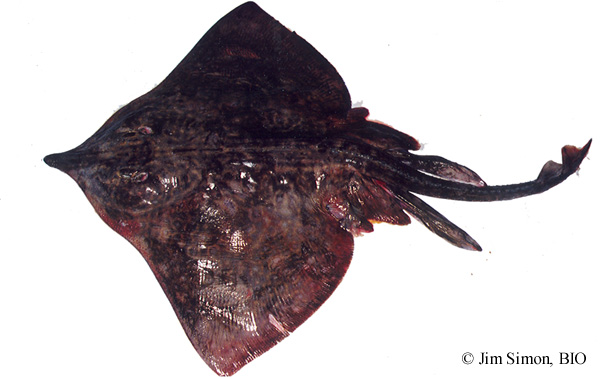Barndoor Skate
Dipturus laevis
Description
The barndoor skate is a very large skate with a depressed body, a diamond-shaped disc, and a long slender tail with lateral folds. The anterior angle of the snout of the barndoor skate is less than 90°. Other distinguishing characteristics include two dorsal fins approximately equal in size located near the end of the tail and separated at their bases by a short space; a small caudal fin extending posteriorly from the base of the second dorsal; and pelvic fins that are relatively small and deeply concave between their anterior and posterior lobes. The barndoor skate has a median row of comparatively small thorn-like spines extending from opposite the axils of the pectoral fins to the base of the first dorsal, flanked by one or two rows of sharp spines on either side. Small spines are also apparent on the snout; along the front edges of the pectoral fins; and in front of and behind the eyes of both male and female barndoor skate. Males have a patch of erectile hooks near the outer edge of each pectoral. The underside of the barndoor skate is smooth except for a prickly area along the margin of the snout, with extends to the nostrils in females. The teeth of male barndoor skate are pointed (whereas the teeth of females are flat) and the claspers of fully mature males are large, extending about three-quarters the distance from the axils of pelvics to first dorsal. Coloration in the barndoor skate is distinctive. The upper surface is brownish with scattered dark spots - including a large dark blotch on the inner portion of each pectoral - and the lower surface is white but heavily blotched with gray, and is covered in tiny mucous pores marked with black pigment.
Size
The barndoor skate is the largest member of the family Rajidae found in the northwestern Atlantic, reaching a total length of approximately 152 cm.
Range
The bardndoor skate occurs in the western North Atlantic mainly from the Gulf of St Lawrence and the southern Grand Bank southward along the continental shelf off Nova Scotia to Georges Bank, the Bay of Fundy and the Gulf of Maine. The southernmost limit of the barndoor skate's range is unknown; however, this species ranges at least to Cape Hatteras, NC. Recent analysis of Canadian research vessel (RV) survey data and commercial fisheries data suggests that the overall distribution of this species may in fact be more extensive than previously reported, both in terms of depth and northern range. For example, barndoor skate have been captured as far north as the Labrador Shelf and into depths of about 1600 m, with higher catches occurring at depths below a previously reported maximum depth of 450 m.
Habitat
This is a bottom-dwelling species that occurs on all types of substrate on the continental shelf from shoal waters to depths greater than 750 m. It tolerates a wide range of temperatures, from 1.2 - 20°C. The migration patterns of the barndoor skate are unknown. There have been reports of offshore seasonal migrations in the summer (with populations inhabiting inshore areas generally seeking cooler temperatures) and inshore migrations in the winter/spring; however, other observations suggest movement into shoal waters during the summer.
Life History
The barndoor skate was recently recognized as close to extinction due to overfishing. Declines in abundance of the barndoor skate are thought to be due - in part - to its "slow" life history characteristics such as large body size, slow growth, late maturity, and great longevity. However, a lack of basic life history information has hampered an accurate assessment of the status of the barndoor skate in most areas of its range, including all waters off the coast of Atlantic Canada. To date, only one published study exists on the life history characteristics of the barndoor skate, with the results listed in the table below.
| Area | Max size (cm) | Longevity (yrs) | Size-at-maturity (cm) | Age-at-maturity (yrs) |
|---|---|---|---|---|
| Georges BankFootnote 1 | 133.5 | 11 | 107.9 (males) 116.3 (females) |
5.8 (males) 6.5 (females) |
Diet
The barndoor skate has been described as a voracious predator, with a diet consisting of all types of benthic organisms from bivalve mollusks, squid, rock crabs, lobsters, shrimp, and marine worms to a variety of fishes including spiny dogfish, alewife, Atlantic herring, butterfish, sand lance, cunner, hakes, and flatfishes.
Reproduction
Knowledge of the reproductive biology of the barndoor skate is limited. The presence of females with fully developed egg capsules around Sable Island in December and January suggests that spawning probably occurs during the winter months. The egg capsules of the barndoor skate are large and yellowish, measuring about 12.7 cm long and 7 cm wide, with very short horns less than 2.5 cm long projecting from each corner of the egg case.
Interaction with people
The barndoor skate is of low market value. However, given the large size of the barndoor skate, it is commonly caught as bycatch in finfish and scallop dredges in the NW Atlantic. When taken incidentally, it used to be used to manufacture fish meal and pet food. At present, commercial landing of this species is prohibited in the Gulf of Maine, due in part to a listing of this species as endangered by the IUCN. Overfishing of the barndoor skate is thought to be responsible for dramatic declines in abundance and the near extirpation of this species from parts of its northern range.
- Date modified:


